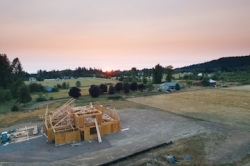[Blog] What Contractors Wish Homeowners Knew About Building or Renovating a Home
Energy Disrupter

Most homeowners don’t know what goes into the planning and construction of a house. And the rise of home improvement programs and DIY home renovation has lead some potential homeowners to make assumptions about what contractors do — and what it takes to build a home from the foundation up. However, most homeowners don’t know the full story of how houses get built.
Below are some common assumptions that homeowners make, and tips that you can use to talk with homeowners about why you renovate in the way that you do.
Everything Has to Be Planned — and Planned Well
Homeowners may come to you with a complete plan of what they want, but without the construction and design experience to ensure that their plan will work.
Room dimensions, light fixtures, wiring and plumbing — almost any of these can get changed during the construction process, but that doesn’t mean those changes are a good idea. Making changes during the construction process is a great way to drive up a project’s budget.
You can let the homeowner know that if they want to keep costs as low as possible, the design should be as close to complete before anything else happens — including buying materials or hiring subcontractors. Get ahead of yourself, and you can easily waste valuable resources.
One advantage a homeowner might have over you as a contractor is that they know what’s best for themselves and their family. They will already know about issues with accessibility, routine or special needs your family members may have. And they probably already know what you want out of your new home.
But a homeowner may not think about the different rooms — bedroom, laundry room and bathrooms — in relationship to each other until they move in and realize all the ways their house could be more efficient.
You may need to explain that if a contractor wants to be involved in the planning process, it’s not because they know what a homeowner needs — instead, it’s because they have the experience necessary to identify common home design pitfalls.
Local Code Isn’t a Recommendation![]()
As a home performance professional, you probably know at least a portion of the local building code. You also likely make sure that every renovation and new construction you work on is up to code.
But homeowners don’t always understand the importance of following building code. They may consider it an unnecessary precaution — or worse, assume you’re trying to drive up the project’s cost.
It’s possible for home performance contractors to avoid this conflict with a little bit of research and discussion with homeowners.
Here are some common housing code violations that can get homeowners in trouble with local authorities:
- Missing handrails on staircases
- Missing or nonfunctional smoke alarms
- Poor or improper bathroom ventilation
- Dangerous electrical wiring
A list like this can help homeowners see that building to code creates a house that’s better to live in.
There are also costs to not following building code. If an inspector believes a house isn’t or won’t be up to code, they can issue a stop-work order. No building can happen while the stop-work order is in place. The homeowner can even get prosecuted for the violation, though this is very rare.
Many older homes aren’t up to code. Sometimes, maintenance is enough for these homes. If a homeowner has never lived in a new building, they may assume this is true for all homes.
For a new building, however, local authorities will be stricter in enforcing the building code.
If a homeowner doesn’t understand why you’re renovating to code, you can educate them on both the long- and short-term costs of not following local building code.
Residential Construction Is a Dangerous Job
To some homeowners, home construction may seem less dangerous than large-scale work sites — despite the fact that residential construction is still risky for contractors.
Falls are one of the most common causes of accidents in residential construction. When a contractor needs to get to a difficult-to-reach area, such as the gutters on a three-story house, a ladder might work. But in the interests of safety, contractors may use specialized equipment to reach those heights. There’s no reason to risk a fall when there are machines that make the job easier and safer.
You may have to explain to some homeowners that just because something seems like it could get done cheaper, doesn’t mean it can. Safety might cost you in time or money, but the alternative is ignoring some of the major risks that come along with home and residential construction.
Contractors Know When to Get Advice
A contractor knows when to give advice or bring in someone who really knows their stuff. A general contractor may have to bring in someone with specialized knowledge about a certain area. Some contractors may feel comfortable making small changes to an HVAC system or wiring but will look for subcontractors for larger-scale changes.
Homeowners might not understand why you turn to other professionals — especially if you are a general contractor, which is often taken to mean that you’re a jack of all trades.
In a case like this, explain how shoddy wiring can quickly become a fire risk. Or how a poorly designed HVAC system can lead to moisture issues and black mold. Home improvements such as roofing, rewiring or plumbing repairs are also dangerous — it is not hard to hurt yourself when electricity, power tools and heights are involved.
You can discuss with homeowners how there’s no shame in deferring to someone with deeper knowledge in a certain area when it comes to wiring, plumbing, heating and cooling. And even if there is, a little bit of shame is better than a client with black mold in their house a few months down the line.
Helping Homeowners Trust Contractors
More thought and planning than most people realize goes into building a home. Contractors wish homeowners would understand how much design work and specialized knowledge is necessary not just to do a good job, but also keep the risks low and costs down.
Luckily, most homeowners will understand why you do what you do with a little bit of explanation. You can help your clients see eye-to-eye with yourself by taking the time to explain the costs of not planning, not taking safety precautions and not seeking expert advice.
















